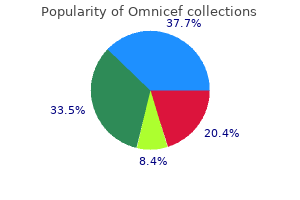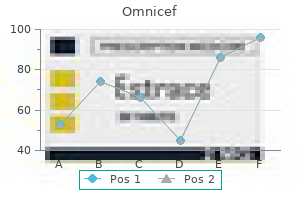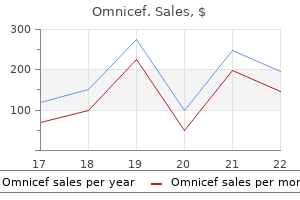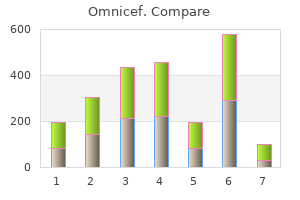"Buy 300 mg omnicef fast delivery, bacteria lesson plans".
L. Boss, M.B. B.CH., M.B.B.Ch., Ph.D.
Assistant Professor, Keck School of Medicine of University of Southern California
Next, we aggressively remove the horizontal portion of the occipital squama with a rongeur virus 66 omnicef 300 mg online. The dura is then opened with a C-shaped incision, with the concavity facing medially, flush with the border of the transverse and sigmoid sinus antibiotics and diabetes 300 mg omnicef amex. At this point we use the operating microscope and expose the inferior portion of the lateral cerebellomedullary cistern by gently supporting the cerebellar tonsil, which is greatly facilitated by extensive removal of the horizontal portion of the occipital squama what causes antibiotic resistance yahoo generic 300 mg omnicef overnight delivery. At this point a self-retaining retractor is used to gently retract the cerebellar hemisphere and expose the tumor. At this stage we drill the posterior lip of the porus acusticus and the internal auditory canal to expose the lateral extent of the tumor. Drilling of the canal must respect the posterior semicircular canal and the common crus in patients with preoperative serviceable hearing. Once intratumoral debulking is completed, separation of the tumor/arachnoid plane is accomplished by gently grasping the tumor or, occasionally, the arachnoid with bayonet forceps and teasing one structure away from the other. Vestibular schwannomas are extra-arachnoidal tumors, so separation of the tumor and arachnoid is possible in the majority of cases. Again, we work on the tumor in a nonsequential manner by going back and forth to different areas. We prefer to not coagulate and instead use temporary packing with topical hemostatic agents for the reasons outlined previously in the meningioma surgical considerations section. Six months postoperatively he had grade 2 House-Brackmann facial function and no other neurologicaldeficit. At this stage, with the tumor sufficiently decreased in size, the vestibulocochlear and facial nerves should be identified at the brainstem. If the patient has serviceable hearing preoperatively, we try to make an effort to save the cochlear nerve even though we know that serviceable hearing will be preserved in only about 10% of patients with a large tumor. After identification of the facial nerve at the brainstem, we start dissecting the tumor from the facial nerve by continuously debulking the tumor so that the capsule collapses on the facial nerve. At this stage we finish removal of the capsule from the facial nerve by sharp dissection. We, as others, have recognized that there is quite a taut adhesion between the tumor and the facial nerve just a few millimeters medial to the porus acusticus and that this area needs to be addressed with great caution. After removal of tumor in the cerebellopontine angle is completed, tumor is removed from the internal auditory canal under combined direct microscopic/endoscopic vision. This intraoperative situation needs to be recognized and adjustments made, such as going back to this area when the gross tumor bulk has been removed and one has greater room and more trajectories through which to carry out this dissection. We use a facial nerve stimulator very liberally during the procedure, and we consider it helpful in locating the facial nerve and assessing its functional continuity at the end of the operation. The midline location of most dermoid cysts could be related to this mechanism, whereas inclusion of ectoderm at a later stage of development during formation of the secondary cerebral vesicles could account for the lateral location of most epidermoid cysts. The content of the cyst is formed by remnants of exfoliated cells (keratinous material and cholesterol) in both types of cysts, and the inside of dermoid cysts also contains the secretion of sebaceous gland entangled in hairs. If intradural dermoids rupture, their contents may spill into the ventricular or subarachnoid space and cause chemical meningitis, which is a very serious complication requiring emergency treatment. This approach has in many cases been used in lieu of a more morbid transfacial approach. Therapeutic Plan Treatment of a symptomatic dermoid/epidermoid cyst is complete surgical excision. There have been isolated reports of epidermoids responding to Gamma Knife treatment. Removal of the contents with only partial removal of the cyst wall is associated with a high incidence of recurrence of the mass lesion. However, at times firm adhesions between the tumor matrix and neurovascular structure make it impossible and not advisable to completely excise the tumor capsule. In the head and neck, paragangliomas are located at the carotid bifurcation (carotid body tumors), at the superior vagal ganglion (glomus jugulare tumors), at the auricular branch of the vagus (glomus tympanicum tumors), and at the inferior vagal ganglion (glomus vagale tumors). Even though glomus tympanicum tumors may extend into the skull base, glomus jugulare tumors are the ones commonly grouped with skull base tumors.

Theoretical advantages of endoscopic resection include improved visualization and illumination, avoidance of facial or scalp incisions, functional and structural preservation of uninvolved structures, minimal trauma to surrounding structures, shorter hospital stays, and lower cost antibiotic horror omnicef 300 mg order without a prescription. Lund and associates reported a 5-year overall survival rate of 88% and a disease-free survival rate of 68% in a cohort of 49 patients with sinonasal malignancies managed by endoscopic resection with intent to cure antibiotics for uti and kidney stones buy omnicef 300 mg with mastercard. Of particular interest is the excellent outcome of patients in their series with mucosal melanoma antibiotics dogs purchase omnicef 300 mg with amex. The authors do not counsel endoscopic resection in isolation if there is transdural tumor extension, for which craniofacial resection is typically recommended. Similarly, given the more extensive invasiveness and perineural propagation associated with adenoid cystic carcinomas, open techniques are typically recommended by this group. Preoperative identification of dural, brain, or intraperiorbital tumor extension was a contraindication to endoscopic resection in isolation, and craniofacial resection was offered. Of the early recurrences noted in this series, the roof of the ethmoid sinus, the sphenoidal sinus, and the nasal septum were the most likely sites of recurrent disease. AdjuvantTherapies Radiotherapy is an important treatment modality for malignant paranasal sinus tumors. The most widely accepted view is that radiotherapy should be given after surgical resection of the tumor, especially if complete resection is not achieved. Several studies comparing patients treated by surgery alone with a similar group given additional postoperative radiotherapy showed that the addition of radiotherapy improved local control. A proposed alternative to surgical excision and postoperative radiotherapy is radiotherapy alone with a curative intent. In a series of 48 patients with malignant paranasal sinus disease, Parsons and colleagues achieved an overall 5-year survival rate of 52% with radiotherapy alone. There was a 33% (16 of 48) incidence of unilateral blindness in this series and an 8% (4 of 48) incidence of bilateral blindness. Of concern is that none of the 4 patients who were left totally blind had orbital invasion. Similarly, not all the patients with treatment-induced unilateral blindness had orbital invasion. For advanced, unresectable tumors, high-dose radiotherapy alone results in 5-year survival rates of 10% to 15%. Treatment generally consists of 60 Gy delivered to the tumor bed, with adjustments as needed to limit the dose to the optic chiasm to 54 Gy. If orbital exenteration has not been performed, it is important to construct the treatment fields so that they spare the lacrimal gland to avoid exposure keratitis. The cervical lymphatics are also treated in patients with advanced squamous cell carcinoma of the maxillary sinus because a high incidence of regional treatment failure (38%) occurs when the lymphatics are not treated. Because the prognosis of tumors of higher stage (T3/T4) is related more to primary disease recurrence than to the presence of nodal metastases, prophylactic irradiation is not required. Three-dimensional radiotherapy planning has been developed to deliver higher doses of radiation to the target volume while avoiding damage to surrounding structures. The use of chemotherapy to treat paranasal sinus tumors was previously limited to the treatment of patients with systemic disease and for palliation in patients with massive recurrent tumors who had few other therapeutic options. Using this method for induction chemotherapy, Lee and associates127 achieved an immediate tumor response in 91% of patients. Some advocate a preoperative trial of cisplatin in all patients who have large paranasal sinus tumors with intracranial extension129 because substantial regression of the tumor may allow easier and more complete excision. In one series, patients with locally advanced or massive recurrent disease received cisplatin infusions in conjunction with hyperfractionated radiation administered over a period of 8 weeks and achieved a 92% response rate and a 58% survival rate after 3 to 6 years. The mean follow-up interval for the 50 patients who were still alive at the end of the study period was 34 months (range, 1 month to 10. Calculation of survival times in the 26 patients who died revealed that most (74%) did so in the first 20 months after surgery. Twenty-seven patients (36%) experienced complications, and 1 died (1%) on the second postoperative day as a result of cardiac dysrhythmia. In various reports, factors that had a significant effect on patient outcome were a tumor that had malignant histology, involved the brain, or involved the orbit. In this group of patients, the most important factors affecting overall and progression-free survival were the ability to achieve resection margins that were negative for tumor, when viewed microscopically, and the lack of direct brain invasion. Patients with malignant tumors showing primary involvement of the sphenoidal sinus, although constituting only 1% to 2% of all patients with paranasal sinus tumors, are an especially difficult subgroup to manage effectively.

However, after imaging was performed, the patient was moved away from the magnetic isocenter, beyond the 5G line virus chikungunya buy discount omnicef 300 mg on line. In this magnetic "fringe field," conventional surgical equipment, including drills and electrocautery, could be used antibiotics for acne and probiotics buy discount omnicef 300 mg on-line. Needle-stabilizing devices were soon developed because freehand biopsies have often been criticized for being inaccurate and potentially increasing the risk for acute intracerebral hemorrhage infection quality control staff in a sterilization unit of a hospital cheap 300 mg omnicef amex. Stereotactic biopsy has often been used to distinguish recurrent neoplasm from postirradiation necrosis, given the similarity of these two findings on imaging scans. This is especially true for intracranial hemorrhage, which has been reported to occur in 0% to 11. Transsphenoidal Resection of Pituitary Adenomas Although the first transsphenoidal approach for pituitary adenoma removal was performed more than a century ago,44 it was relatively recently, with the development of adjuvant technologies, that it became the method of choice in the resection of pituitary tumors. Although fluoroscopy allows for rapid real-time imaging, its visualization is limited to the bony structures of the sella, and it is unable to aid in tumor detection. Finally, despite the drastic improvement that endoscopy has provided relative to the surgical microscope alone, it requires direct visualization to confirm the presence or absence of tumor and does not allow one to see beyond the surface anatomy. Given these limitations, it is not surprising that complete removal of pituitary adenomas remains a problem, with studies suggesting that this is achieved in only about 65% of macroadenoma cases. Serial updates allow the neurosurgeon to localize remnant tumor while accounting for brain shift throughout the surgery and to direct resection while preserving critical native structures. Furthermore, dynamic image sequences help distinguish normal pituitary tissue (fast contrast enhancement) from adenoma (slow contrast enhancement) and hemorrhage (heme-sensitive gradient echo). This allows the surgeon to determine on the day of surgery whether further management is required, rather than waiting the standard 2 to 3 months for artifact-free postoperative scans to decide among surveillance, radiation therapy, or secondary transcranial surgery. Consequently, it may be too early to conclude whether the reported imaging outcomes translate into truly beneficial clinical outcomes that can be compared with national statistics derived from studies with more than 10 years of follow-up. Intractable Epilepsy Although surgery has been a treatment option for pharmacoresistant epilepsy for more than 50 years, it was only recently that a randomized controlled trial53 investigated the efficacy of surgery compared with medical management. This outcome, in conjunction with other reports of increased seizure-free intervals after surgery, has continued to support this invasive treatment option over the years. Surgical techniques available for intractable epilepsy include focal cortical resection, anatomic lobectomy, lesionectomy, corticectomy, and hemispherectomy and its variants. For example, patients with epilepsy secondary to a specific seizure focus, including neoplasms and vascular malformations, undergo focal cortical resection to remove the epileptogenic lesion; alternatively, mesiotemporal lobe epilepsy patients with hippocampal sclerosis benefit from amygdalohippocampectomy or en bloc temporal lobe resection. Overall, they report the utility of intraoperative imaging at helping navigate through cortex while accommodating for brain shift as well as aiding in the detection and resection of residual epileptogenic structures or lesions. Schwartz and associates55 published similar results in a small study in which 100% of their patients were seizure free at 10 months. Because neuronavigation is based on preoperative images, brain shift during neurosurgery induces error and uncertainty in the neuronavigation system. Factors such as feasibility, safety, patient selection, and cost will play important roles in the future adaptation of this technologic advancement. Craniotomy for tumor treatment in an intraoperative magnetic resonance imaging unit. Glioma resection in a shared-resource magnetic resonance operating room after optimal image-guided frameless stereotactic resection. Intraoperative visualization of the pyramidal tract by diffusion-tensor-imaging-based fiber tracking. Magnetic resonance imaging-guided neurosurgery in the magnetic fringe fields: the next step in neuronavigation. Intraoperative diagnostic and interventional magnetic resonance imaging in neurosurgery. However, continued use of antiepileptic drugs can be necessary, and in some patients, an additional operation may be required for persistent seizure activity. In our experience, optimal control of intractable epilepsy without the use of postoperative anticonvulsants is possible when perioperative.


This diversity makes it difficult for neuropathologists to appreciate the subtleties of histologic diagnosis when only small specimens are available infection zombie movie omnicef 300 mg order visa. For the third of tumors that are benign, resection is usually complete and curative, thus making it the clear procedure of choice (Table 1253) antimicrobial 109 key 24 ghz soft silent key flexible wireless keyboard 300 mg omnicef generic free shipping. However, stereotactic biopsy carries a risk for hemorrhage from several mechanisms, including bleeding in highly vascular tumors, damage to the deep venous system, and bleeding into the ventricle, where tissue turgor is insufficient to tamponade minor bleeding antibiotics kombucha omnicef 300 mg otc. Computed tomography is sufficient to provide accurate targeting information and to track the trajectory in three dimensions. Volumetric treatment planning should be used to identify the trajectory in all the axial, sagittal, and coronal planes. The alternative approach is through a posterolaterosuperior approach near the parietooccipital junction, which can be useful for tumors that extend laterally or superiorly. Serial biopsies are desirable whenever possible; however, this is often prohibited by the small size of the tumors commonly encountered. If bleeding is encountered, continuous suction and irrigation for up to 15 minutes may be necessary. When bleeding is suspected, an immediate scan should be obtained to assess for intraventricular blood and the degree of hydrocephalus to determine the need for ventricular drainage. Endoscopic Biopsy Endoscopic biopsy of pineal tumors through the ventricles has been reported as an alternative method for securing a tissue diagnosis. However, even with flexible endoscopes, it is difficult to perform a biopsy simultaneously with a ventriculostomy because the trajectory required is different for each procedure. The rigid endoscope is not easily maneuverable without risk of damage to the fornix and the septal and thalamostriate veins at the foramen of Monro. A suitable entry point through the forehead might allow the use of a rigid scope, but this offers no advantage over a simple stereotactic biopsy. More typically, endoscopes have been used to aspirate pineal cysts; however, the benefits of this approach are equivocal. The tumor can then be dissected more easily off the deep venous system and velum interpositum, which is often the most technically difficult portion of tumor dissection. Besides the obvious anatomic advantage of using a midline trajectory, the deep venous system lies dorsal to the mass, thus making it more avoidable through most of the tumor dissection. The approach is less favorable if the tumor has a significant supratentorial or lateral extension, although with appropriate extra-long instruments, even tumors extending anteriorly into the third ventricle can be removed. Operative Procedures Several variations on approaches to the pineal region exist, but essentially they are categorized as supratentorial or infratentorial. Large tumors that extend supratentorially or laterally to the trigone of the lateral ventricle generally benefit from a supratentorial approach. Sitting Position the sitting position is usually preferred for the infratentorial supracerebellar approach. The risks for air embolism, pneumocephalus, or subdural hematoma associated with cortical collapse can be anticipated and managed with proper precautions. A Greenberg self-retaining retractor or similar system is arranged to frame the operative field to assist in cerebellar retraction and serve as a holder for cottonoids. Lateral Position the lateral decubitus position with the dependent, nondominant right hemisphere down is generally used. The three-quarter prone position is essentially an extension of the lateral position, except that the head is at an oblique 45-degree angle with the nondominant hemisphere dependent. This is suitable for more posterior approaches, such as the occipital transtentorial as opposed to the transcallosal approach. A supporting roll is placed under the left thorax, and a three-point head-pin vise holder is used to support the head in a slightly extended and rotated position to the left at a 45-degree oblique angle. The patient is securely strapped, and the legs and feet are elevated to facilitate venous return. Prone Position the prone position is simple and safe for supratentorial approaches. This position is useful when two surgeons work together through an operative microscope that has a bridge to allow simultaneous binocular vision.

